Affiliate Disclosure: This post may include affiliate links. If you click and make a purchase, I may earn a small commission at no extra cost to you.
Seagate Firecuda 530 is advertised as a gaming-oriented drive with a higher price tag than other Gen 4 SSDs. But the performance isn’t as good as it seems. Also, it is priced too high for what it offers.
The Samsung 990 Pro is equipped with a much denser, more efficient NAND flash (V8 V-NAND) than the Firecuda 530’s B47R FortisFlash. Also, the Pascal controller in the 990 Pro is much more advanced than the Phison E18 in the Firecuda 530. Both SSDs have their own DRAM.
The Firecuda 530 promises sequential read speeds of 7,300 MB/s and write speeds of 6,900 MB/s. The 990 Pro achieves almost the same speeds as advertised: 7,450 MB/s for sequential reads and 6,900 MB/s for sequential writes. The advertised random IOPS are higher in the 990 Pro, and this is where we see the performance difference in day-to-day usage.
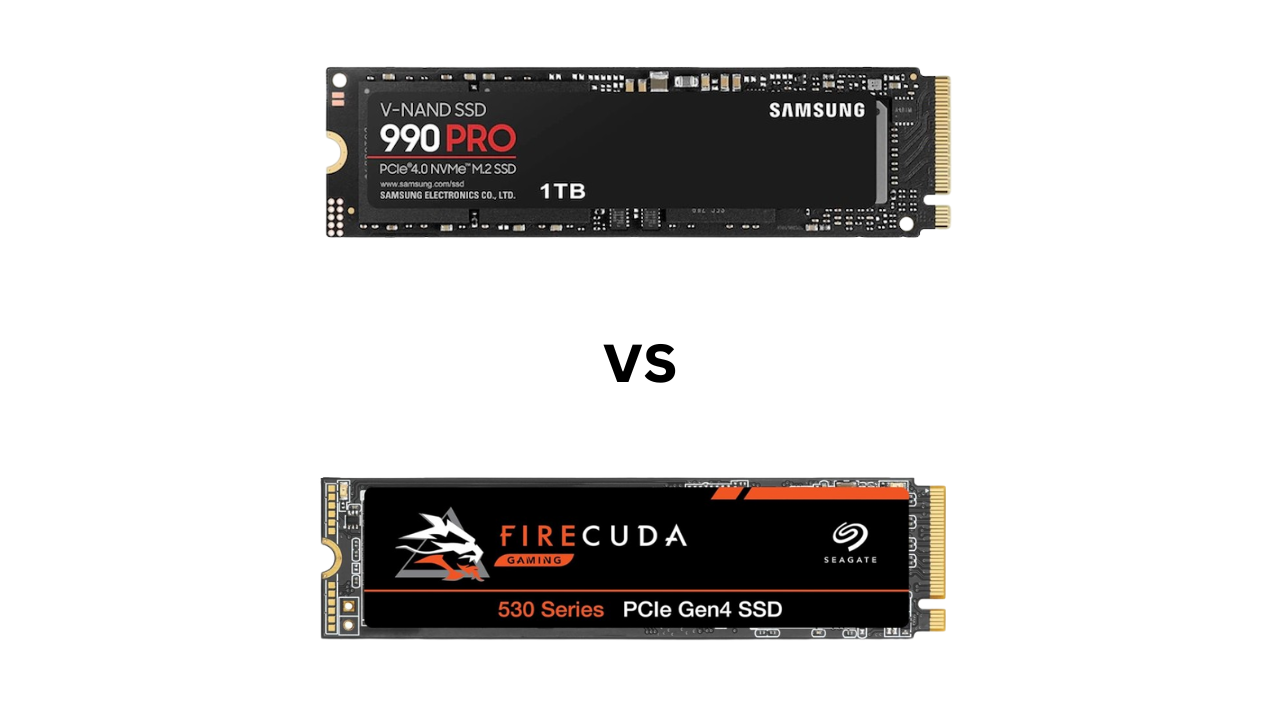
Now, let’s compare the theoretical specifications, benchmarks, and other things to reach a final decision.
Samsung 990 Pro vs Seagate Firecuda 530 Specs
| Specification | Samsung 990 Pro | Seagate Firecuda 530 |
|---|---|---|
| PCIe Generation/NVMe Version | PCIe Gen 4.0 x4/ NVMe 2.0 | PCIe Gen 4.0 x4/ NVMe 1.4 |
| Release Year | 2023 | 2020 |
| Capacities | 1TB, 2TB, 4TB | 500GB, 1TB, 2TB, 4TB |
| Sequential Read Speed | 1TB: 7,450 MB/s 2TB: 7,450 MB/s 4TB: 7,450 MB/s | 500GB: 7,000 MB/s 1TB: 7,300 MB/s 2TB: 7,300 MB/s 4TB: 7,300 MB/s |
| Sequential Write Speed | 1TB: 6,900 MB/s 2TB: 6,900 MB/s 4TB: 6,900 MB/s | 500GB: 3,000 MB/s 1TB: 6,000 MB/s 2TB: 6,900 MB/s 4TB: 6,900 MB/s |
| Random Read Speed | 1TB: 1,200K IOPS 2TB: 1,400K IOPS 4TB: 1,400K IOPS | 500GB: 400K IOPS 1TB: 800K IOPS 2TB: 1,000K IOPS 4TB: 1,000K IOPS |
| Random Write Speed | 1TB: 1,550K IOPS 2TB: 1,550K IOPS 4TB: 1,550K IOPS | 500GB: 700K IOPS 1TB: 1,000K IOPS 2TB: 1,000K IOPS 4TB: 1,000K IOPS |
| NAND Flash | Samsung V8 V-NAND TLC | B47R FortisFlash TLC |
| DRAM | Yes | Yes |
| Controller | Samsung Pascal | Phison E18 |
| Pricing | Starting at $92.99 (1TB) | Starting at $119.71 (500GB) |
The Samsung 990 Pro and Seagate FireCuda 530 are both high-end PCIe Gen 4 NVMe SSDs, but they represent different generations and design philosophies. The 990 Pro, released in 2023, is Samsung’s newer, more refined drive, pushing slightly better real-world performance thanks to NVMe 2.0 and its in-house Pascal controller paired with 8th-gen V-NAND. It offers consistently high read/write speeds and excellent random performance, making it great for gamers, professionals, and power users who hammer their drives with heavy workloads.
The FireCuda 530, from 2020, still holds its own with Phison’s E18 controller and B47R TLC NAND, but it’s clearly showing its age. Lower random speeds, less efficient firmware, and a higher entry price for lower-capacity models are among the key issues with this drive. While the FireCuda 530 was the king of Gen 4 when it launched, the 990 Pro clearly beats it with higher performance, better efficiency, and a stronger value proposition.
Benchmark Scores Comparison
All the benchmark scores are for the 2TB variants of both drives.
PCMark 10 Benchmark
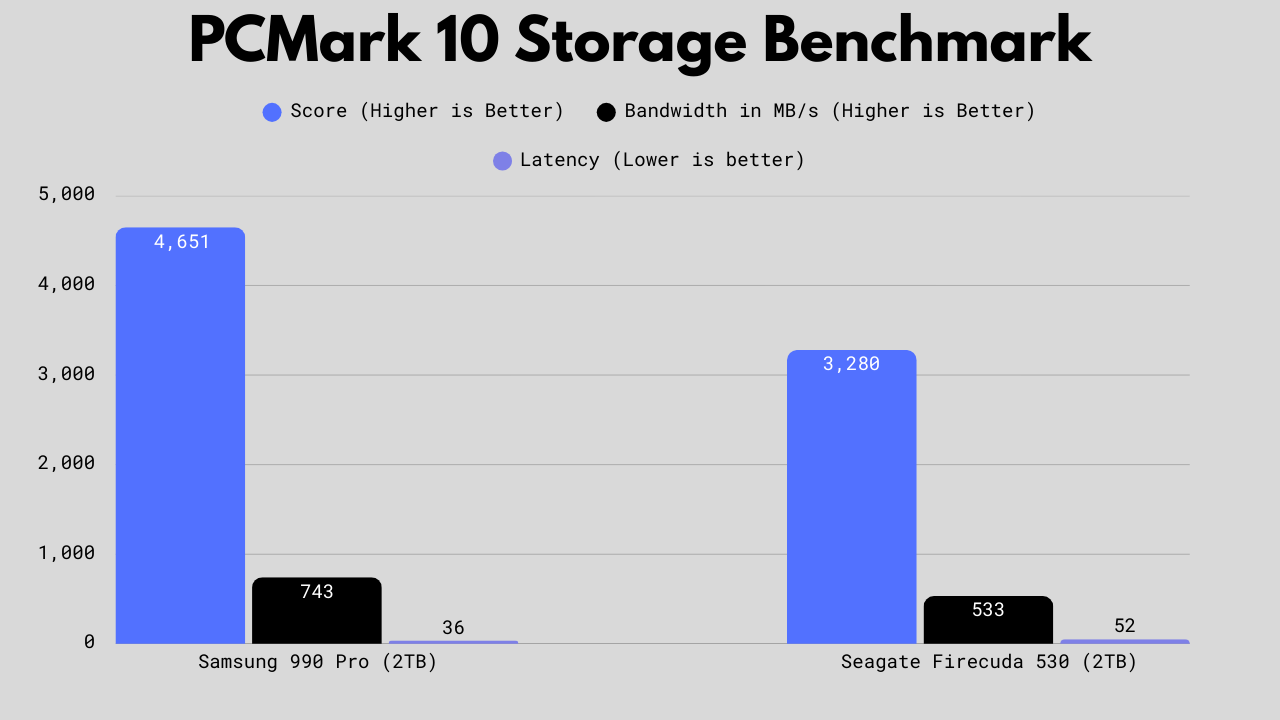
Looking at the benchmark scores, the Samsung 990 Pro clearly outperforms the Seagate FireCuda 530 in all key metrics. With a significantly higher overall score of 4,651 versus 3,280, it also delivers a higher bandwidth of 743 MB/s versus 533 MB/s. Additionally, the 990 Pro has a lower latency of 36 µs versus 52 µs, enabling it to respond more quickly to read/write requests. This will be helpful in tasks that require fast access to small files or intensive random I/O operations. Overall, the 990 Pro offers a more responsive and higher-throughput experience, while the FireCuda 530, though still strong, lags in raw speed and latency.
3DMark Storage Test for Gamers

In the 3DMark storage benchmark, the Samsung 990 Pro maintains a clear edge over the Seagate FireCuda 530, although the gap is narrower than in the previous test. The 990 Pro achieves a higher score of 4,816, compared to 4,113, with a superior bandwidth of 818 MB/s, compared to 709 MB/s, indicating faster sequential and sustained transfers. Its latency remains lower at 36 µs, down from 44 µs, ensuring quicker response times for random I/O operations. While both drives perform exceptionally well, the 990 Pro consistently delivers slightly better throughput and responsiveness, making it the more optimal choice for gaming and 3D-related tasks.
CrystalDiskMark Sequential Read/Write Performance
For the CDM sequential read/write benchmarks, we have used 1 MiB data blocs at the queue depths of 1 and 8, respectively.

The Samsung 990 Pro wins in sequential read speeds at both low and high queue depths, with a slight but consistent advantage of about 2–3% faster on reads. On the other hand, the FireCuda 530 pushes slightly higher write speeds, especially at QD1, showing better burst write performance. The QD8 write results are identical, meaning both drives handle sustained workloads equally well.
Overall, the Samsung 990 Pro is better suited for read-heavy tasks like gaming or loading large apps quickly, while the FireCuda 530 is the better pick for users doing frequent writes, like video editing or large file transfers.
CrystalDiskMark Random Read/Write Performance
For the CDM random read/write benchmarks, we used 4KB data blocks at queue depths of 1 and 256, respectively.
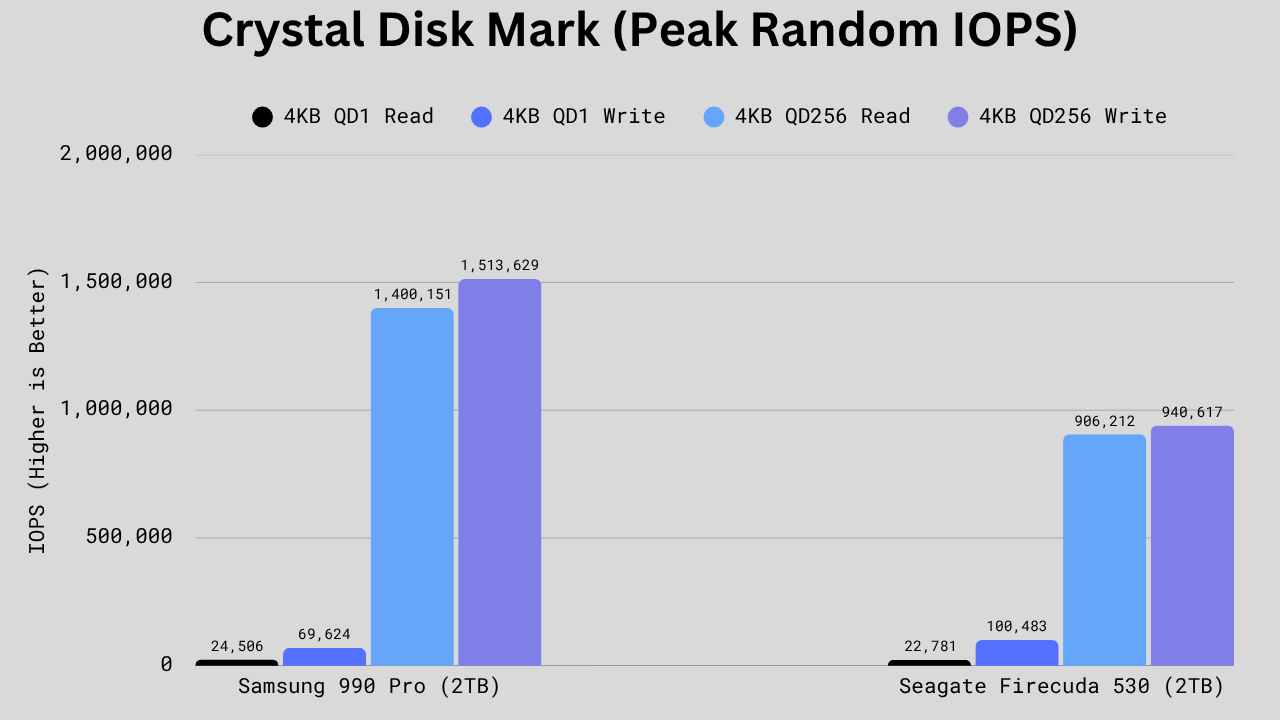
Here, the differences are more dramatic. The 990 Pro crushes the FireCuda 530 in high-queue-depth performance, with nearly 55% higher peak speed in 4KB QD256 reads and about 60% higher peak speed in 4 KB QD256 writes. However, at QD1 (light workloads), it’s a mixed bag: Samsung leads in read performance, but Seagate has come back in write speed, outperforming it by around 44%.
In short, the 990 Pro shines for heavy multitasking, data-intensive workloads, and server-like environments, while the FireCuda 530 is stronger for quick, small-scale write operations and light desktop use.
File Transfer Rate

The Samsung 990 Pro handles large file copies better, moving a 50GB folder roughly 15% faster than the FireCuda 530. But when it comes to reading a smaller compressed file, the FireCuda takes a slight lead, though the difference is tiny and would be hard to notice in real use.
Power Consumption and Efficiency
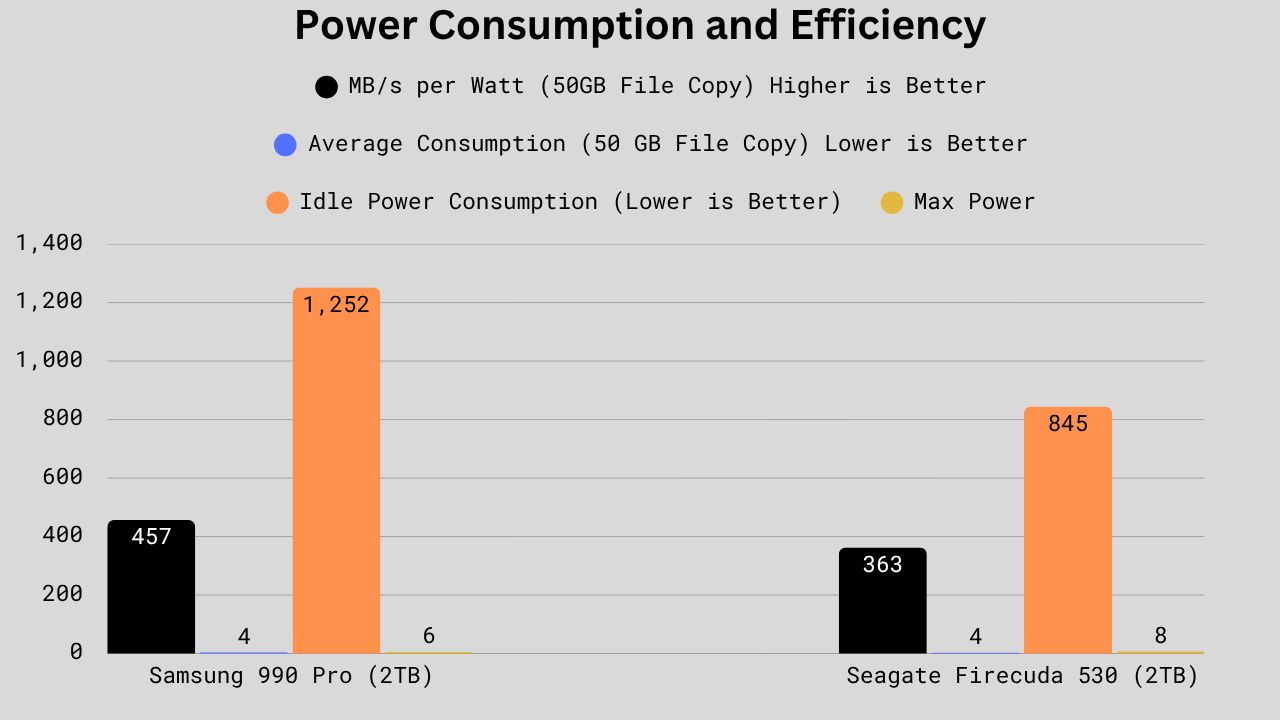
The 990 Pro proves to be more power-efficient during heavy file transfers, delivering noticeably better performance per watt. Both drives draw similar power under load, but the FireCuda 530 sips less when idle, making it slightly friendlier for extended idle periods. However, it spikes higher at peak usage, which isn’t ideal for compact systems.
TBW, DWPD, MTBF, and Warranty
| Specificiation | Samsung 990 Pro | Seagate Firecuda 530 |
|---|---|---|
| TBW (Terabytes Written) | 1TB: 600 TBW 2TB: 1200 TBW 4TB: 2400 TBW | 500GB: 640 TBW 1TB: 1275 TBW 2TB: 2550 TBW 4TB: 5100 TBW |
| DWPD (Drive Writes per Day) | 0.3 | 0.7 |
| MTBF (Mean Time Between Failure) | 1.5 Million Hours | 1.8 Million Hours |
| Warranty | 5 Years Limited | 5 Years Limited |
The FireCuda 530 just crushes the 990 Pro in endurance. Its TBW ratings are roughly double those of the 990 Pro across the board, and its DWPD figure more than doubles Samsung’s. That means it can handle far more daily writes without wearing out. It also has a slightly higher MTBF, suggesting better long-term reliability on paper. Warranty terms are identical, so the real difference is durability, not coverage.
In short, the FireCuda 530 is the clear winner for heavy-duty, write-intensive workloads like professional editing or data logging, while the 990 Pro is better suited for high-speed consumer use where endurance isn’t pushed to the limit.
Technical Specifications
| Specification | Samsung 990 Pro | Seagate Firecuda 530 |
|---|---|---|
| Controller | Samsung’s Pascal (S4LV008) | Phison E18 |
| Controller Architecture | ARM 32-bit Cortex-R8 | ARM 32-bit Cortex-R5 |
| DRAM Specifications | Samsung’s LPDDR4 DRAM 1TB: 1×1024 MB 2TB: 1×2048 MB 4TB: 1x 4096 MB | DDR4-2666 DRAM 500GB: 1 x 512MB 1TB: 1×1024 MB 2TB: 1×2048 MB 4TB: 1x 4096 MB |
| SLC Write Cache | 1TB: approx. 114 GB (108 GB Dynamic + 6 GB Static) 2TB: approx. 226 GB (216 GB Dynamic + 10 GB Static) 4TB: approx. 442 GB (432 GB Dynamic + 10 GB Static) | 500GB: – 1TB: approx. 55 GB (dynamic only) 2TB: approx. 225 GB (dynamic only) 4TB: approx. 440 GB (dynamic only) |
| NAND Flash | Samsung’s V8 V-NAND | Micron’s B47R FortisFlash |
| Topology | 236-Layers | 176-layer |
| NAND speed | 2400 MT/s | 1200 MT/s |
| Read Time (tR)/Program Time (tProg) | 40 µs/390 µs | 56 µs/502 µs |
| Die Read Speed | 1600 MB/s | 1143 MB/s |
| Die Write Speed | 164 MB/s | 127 MB/s |
| Encryption | AES-256, TCG Opal | AES-256 |
| SMART/TRIM/PS5 Support | Yes/Yes/Yes | Yes/Yes/Yes |
| More Information | Check Datasheet | Check Datasheet |
The Samsung 990 Pro’s hardware is clearly more advanced. Its Pascal controller with Cortex-R8 cores is newer and faster than the FireCuda’s Phison E18 setup, and its 236-layer V-NAND runs at twice the interface speed. These specs clearly mean faster read/write times at the die level and tighter overall latency. Samsung also includes a mix of static and dynamic SLC cache, while the FireCuda relies purely on dynamic caching, which can make Samsung’s performance more consistent under sustained loads. The only real edge for Seagate is endurance, not raw tech.
So, if you want a great architecture and faster NAND with smoother sustained performance, the 990 Pro is the better drive. If you prioritize lifespan and can live with slightly slower internals, the FireCuda 530 makes more sense.
Price
As we discussed earlier, all the matching variants of the Firecuda 530 are way expensive than the 990 Pro. However, prices keep changing, and they vary depending on the marketplace you choose. So, make sure to double-check the prices before you make your decision.


Conclusion: Which One Should You Choose?
Between these two, the Samsung 990 Pro is a clear winner in terms of performance, specifications, thermal efficiency, and power consumption. It offers you a good balance of price and performance. With the NVMe 2.0, V8 V-NAND, and a much better controller than the Firecuda 530, the Samsung 990 Pro will always be a better choice.
The Firecuda 530 has higher TBW and DWPD ratings than the 990 Pro. The performance isn’t that bad, but it’s not as good as its pricing. So, there are no other good reasons to take this drive unless you are getting heavy discounts. So, I would recommend the Samsung 990 Pro over the Firecuda 530 any day.
I hope this helps.





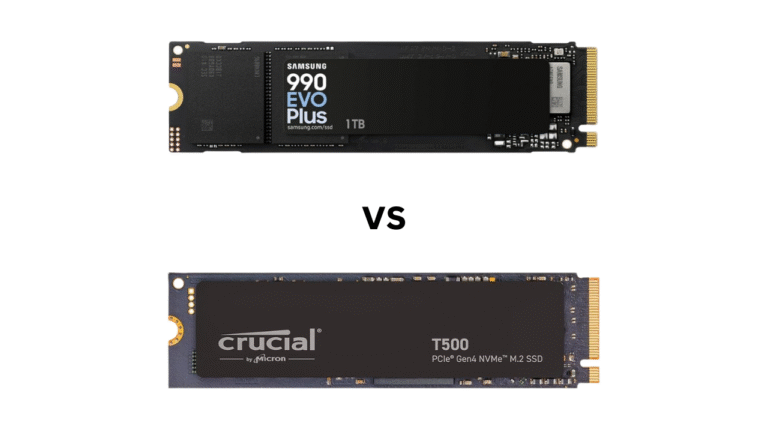
![How to Buy and Upgrade Laptop RAM? [Detailed Guide]](https://storedbits.com/wp-content/uploads/2024/10/push-the-ram-stick.jpg)